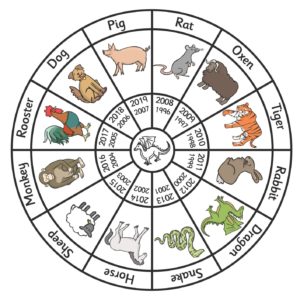
Here in Manchester, Chinese New Year is a big celebration, with a big, colourful Dragon Parade through town and lots of noise!
Perfect for inspiring a splash of colour and imagination into our piano lessons during the misty, grey month of January. So here are some ways we explored Chinese sounds in our piano lessons this week:
Beginners: Pentatonic Improv Piece
The Piano Safari rote/improvisation piece Outer Space got a special new title: Chinese Gong Song
This piece uses the pentatonic scale- so first we explored messing about with the scale on the black keys and making Chinese-sounding or ‘Kung Fu’ tunes.
Then we looked at the animals in the Chinese Zodiac:
They loved seeing which they were, which I was and then trying to work of my year of birth!
We experimented improvising contrasting animals sounds using some questions as prompts: would it be high or low, fast or slow, loud or quiet?
We improvised a ‘Dragon Parade’ marching up the black keys slowly getting louder.
Then then chose some animals for the 2 improvisation sections of Chinese Gong Song and I had to guess which one they did first. We used the words ‘Happy New Year to you’ to help feel the rhythm of the rote section.
Rhythm game: Blind Mirror
For beginners learning crotchet /quaver (ta/ tati) rhythms we used these cute (and free!) Chinese New Year animal rhythm cards
We sit back to back, and each choose 4 cards at random. Lay the cards out in a 4 beat rhythm pattern, and tap or say it. We each write down what we heard, on a white board and then compare.
Keyboard Game: Dragon Builder.
Using coloured alphabet cards we played a game to build ‘dragons’ (on a paper keyboard- about 4 or 5 octaves in length). I like using floor activities to get them off the bench and keep focus, plus no danger of these falling under the keys of a real piano!
How to play:
Players take turns to get a card and place it on the correct key.
They need to place it on the key next door to another card if possible, to start building a ‘dragon’ of 8 or more neighbour letters, e.g an A next to a B card. If not, then place it in a different octave to build another ‘dragon’.
When an 8 (octave) or longer chain of letters is made , that’s a dragon. They get a point for each letter and take off that ‘dragon.’ You can be strategic about where you put your letters to try and build a super dragon!
Tip- if playing this just go really fast, as there are over 50 cards….You don’t even really need to take turns! Just go for it. Or do it as a race against the clock and a team effort- can we score more 20 points in 2 minutes of play, for example?
Great for learning keyboard alphabet, spotting patterns and octaves.


